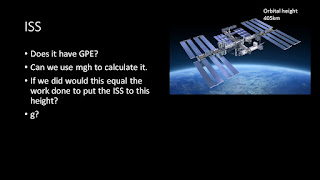Prep
Gravitational Potential
1.
The radius of the Earth is 6370 km and it has
mass 5.97 × 1024 kg. Calculate the gravitational potential on the
surface of the Earth. (2 marks)
2.
Calculate the gravitational potential at a point
3.4 × 106 m from a 7.10 × 1021 kg point mass. (2 marks)
3.
State the effect on the gravitational potential
at a point in a radial field around a point mass if:
a.
a the mass of the point mass creating the field
doubles;
b.
b the distance from the point mass decreases by
a factor of four;
c.
c the mass of the point mass increases by a
factor of three and the distance from the point mass doubles.
4. Explain
why a satellite in a circular orbit at a fixed height does not experience a
change in gravitational potential.
5. The
Sun has mass 1.99 × 1030 kg and diameter 1.39 × 109 m.
Show that the gravitational potential on its surface is about −1.9 × 1011
J kg−1.
6. The
mass of the Earth is 5.97 × 1024 kg and it has radius 6370 km.
Calculate the gravitational potential energy of a 75.0 kg satellite at a height
of 1200 km above the surface of the Earth.
7. Explain
why in order for there to be a change in gravitational potential energy a mass
needs to move vertically in a uniform field.
8.
Calculate the gravitational potential energy of
the following masses at a point in a gravitational field where the
gravitational potential is −32 MJ kg−1: a 40 kg; b 7.4 µg; c 1.67 ×
10−27 kg (mass of a proton).
9. On
the Apollo 14 mission to the Moon, astronaut Alan Shepard smuggled a golf club
on board. He used it to strike a golf ball around 300 m on the surface. The
Moon has mass 7.35 × 1022 kg and radius 1740 km. Calculate the
velocity needed by the golf ball to escape from the surface of the Moon.
10.
The Earth has mass 5.97 × 1024 kg and
radius 6370 km. Calculate the change in gravitational potential energy required
to lift 300 kg into an orbit 50 000 km above the surface of the Earth. (4
marks)
11.
The Sun has mass 1.99 × 1030 kg and
radius 6.96 × 108 m. A very distant comet is ‘caught’ by the Sun’s
gravitational field and accelerates towards the centre of the Sun. Estimate the
speed of the comet at the edge of the Sun




















